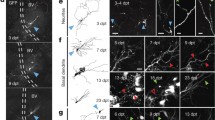We studied the behavior and cell–cell interactions of embryonic brain cell from GFP-reporter mice after their transplantation into the intact adult brain. Fragments or cell suspensions of fetal neocortical cells at different stages of development were transplanted into the neocortex and striatum of adult recipients. Even in intact brain, the processes of transplanted neurons formed extensive networks in the striatum and neocortical layers I and V-VI. Processes of transplanted cells at different stages of development attained the rostral areas of the frontal cortex and some of them reached the internal capsule. However, the cells transplanted in suspension had lower process growth potency than cells from tissue fragments. Tyrosine hydroxylase fibers penetrated from the recipient brain into grafts at both early and late stages of development. Our experiments demonstrated the formation of extensive reciprocal networks between the transplanted fetal neural cells and recipient brain neurons even in intact brain.
Similar content being viewed by others
References
K. K. Sukhinichi, A. V. Podgornyi, and M. A. Aleksandrova, Izv. Ross. Akad. Nauk. Ser. Biol., No. 6, 659-669 (2011).
J. R. Cannon and J. T. Greenamyre, Neurosci. Lett., 464, No. 1, 14-17 (2009).
L. Domballe, F. Gaillard, and A. Gaillard, Exp. Neurol., 180, No. 2, 110-122 (2003).
K. D. Dougherty, C.F. Dreyfus, and I. B. Black, Neurobiol. Dis., 7, No. 6, Pt B, 574-585 (2000).
T. B. Freeman, P. R. Sanberg, M. Nauert, et al., Cell Tansplant., 4, No. 1, 141-154 (1995).
R. A. Fricker-Gates, J. J. Shin, C. C. Tai, et al., J. Neurosci., 22, No. 10, 4045-4056 (2002).
F. Gaillard, L. Domballe, and A. Gaillard, Neuroscience, 126, No. 3, 631-637 (2004).
A. Gaillard and M. Jaber, Cell Adh. Migr., 1, No. 4, 161-164 (2007).
A. Gaillard, L. Prestoz, B. Dumartin, et al., Nat. Neurosci., 10, No. 10, 1294-1299 (2007).
P. J. Hallett, O. Cooper, D. Sadi, et al., Cell Rep., 7, No. 6, 1755-1761 (2014).
L. Hao, Z. Zou, H. Tian, et al., Biomed. Res. Int. doi: 10.1155/2014/468748 (2014).
E. A. Huebner and S. M. Strittmatter, Results Probl. Cell Differ., 48, 339-351 (2009).
P. Lu, Y. Wang, L. Graham, et al., Cell, 150, No. 6, 1264-1273 (2012).
G. Martino, S. Pluchino, L. Bonfanti, and M. Schwartz, Physiol. Rev., 91, No. 4, 1281-1304 (2011).
R. Muramatsu, M. Ueno, and T. Yamashita, Biosci. Trends, 3, No. 5, 179-183 (2009).
J. Nelander, S. Grealish, and M. Parmar, Neuroreport, 24, No. 18, 1025-1030 (2013).
M. Okabe, M. Ikawa, K. Kominami, et al., FEBS Lett., 407, No. 3, 313-319 (1997).
V. Ourednik and J. Ourednik, Ann. N.Y. Acad. Sci., No. 1049, 172-184 (2005).
C. Raposo and M. Schwartz, Glia, 62, No. 11, 1895-1904 (2014).
A. Rolls, R. Shechter, and M. Schwartz, Nat. Rev. Neurosci., 10, No. 3, 235-241 (2009).
B. Saha, M. Jaber, and A. Gaillard, Front. Cell. Neurosci., doi: 10.3389/fncel.2012.00014 (2012).
R. Shechter, A. London, and M. Schwartz, Nat. Rev. Immunol., 13, No. 3, 206-218 (2013).
C. E. Sortwell, M. R. Pitzer, and T. J. Collier, Exp. Neurol., 165, No. 2, 268-277 (2000).
Author information
Authors and Affiliations
Corresponding author
Additional information
Translated from Kletochnye Tekhnologii v Biologii i Meditsine, No. 3, pp. 139-148, July, 2015
Rights and permissions
About this article
Cite this article
Sukhinich, K.K., Kosykh, A.V. & Aleksandrova, M.A. Differentiation and Cell–Cell Interactions of Neural Progenitor Cells Transplanted into Intact Adult Brain. Bull Exp Biol Med 160, 115–122 (2015). https://doi.org/10.1007/s10517-015-3111-6
Received:
Published:
Issue Date:
DOI: https://doi.org/10.1007/s10517-015-3111-6




